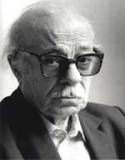Skip to: site menu | section menu | main content
Welcome To Democracy And Socialism .Com
Things should be made as simple as possible, but not any simpler- Albert Einstein
Ernesto Sabato (1911- 2011) |
 |
Just one day before the May Day 2011, Ernesto Sabato died at his home near Buenos Aires, Argentina, he was 99. Sabato was one of the most influential Latin American writers, a scientist, a painter, and a steady fighter for human rights and social justice in the world. Sabato was born in Rojas, Buenos Aires on June 24. He was the 10th of 11 sons of immigrant Italian parents. As a student Sabato had been deeply involved in protests against corrupt military rulers and their intervention in all of the country’s events. First he became an anarchist and after discarding it as a philosophy, joined the underground Communist Party and became a leader of its youth movement. In 1935 he enrolled to attend the international Antifascist Congress in Brussels, but refused to go to Moscow for training. After a few months of self examination Sabato quit the Party appalled by authoritarian methods carried out by Stalin and his circle. He became an ardent iconoclast.
In 1937 Sabato received a doctorate degree in physics, and in1938 he went to Paris and worked on a research fellowship at the Joliot Curie laboratory. A year later he studied at the Massachusetts Institute of Technology (MIT), and published a scientific article on his speciality, Cosmic Radiation. From 1940 - 1945 he taught at the University of La Plata, but was forced to resign by the Juan Peron dictatorship – he was politically unwanted.
After the fall of Peron in a 1955 military coup, Sabato became director of Mundo Argentino magazine, but was removed due to his hard position against the torture of political opponents of the military junta of Pedro Aramburu.
In 1984, after the end of Argentina’s notorious 1976 - 1983 military rules, Sabato was chosen to lead the National Commission investigating on the disappeared in the so-called Dirty War. The Commission looked into the fate of tens of thousands of Argentines who disappeared at the hands of military. It compiled 50,000 pages of chilling evidence of systematic kidnap, torture, rape and killing of leftists and anyone even distantly suspected of sympathizing with them. The report shocked Argentinians with details of almost 9,000 disappearances and 300 secret interrogation sites across the country. It was the first attempt to systemically depict and document the tales of the disappeared; following updates list as many as 30,000 killings.
The result of the Sabato Report was the publication of a book called Never Again, it recommended that the Dirty War soldiers should be tried and punished. The Dirty War was supported and encouraged by the CIA, in Operation Condor, with many of the military leaders that took part in abuses trained in the School of the Americas (Anderson, Martin. Dossier Secreto. Westview Press 1993.)
But the Report’s opening received criticism from the Mothers of the Plaza de Mayo, Sabato wrote that Argentina “was torn by terror from both the extreme right and the far left”. They and many Argentinians argued that the leftist treat was insignificant compared with the heavy handed military response. Among those who disappeared were workers, students, teachers, and other government opponents few of whom were engaged in an organized movement.
In 1985 Sabato received the prestigious Cervantes Prize for the lifetime of literary achievement. He also received the Gran Cruz al Merito Civil in Spain, the Medici award in Italy and several other awards.
Sabato published only 3 novels:
The Tunnel (1948)
On Heroes and Tombs (1961)
The Angel of Darkness (1974)
These novels were the only survivors of his tendency to burn his scripts. “It's not reasonable, really, but all my life I tended to destroy things - my own things - not other people's”, he once said. “It may be because I considered that all my work was imperfect, impure, and I found that fire was purifying”.
“I was about to burn On Heroes and Tombs after many years of work, but my wife became ill because of this decision, so I changed my mind.”
In his later years Sabato shifted to painting. His art works has been exhibited worldwide alongside his books.
Sabato wrote many articles, among them:
One and the Universe (1945)
Men and Mechanisms (1951)
The Sabato Case, Torture and Liberty of Press, Open Letter to General Aramburo (1956)
The Other Face of Peronism (1956)
Culture in the National Crossroads (1973)
Dialogues with Jorge Luis Borges (1976)
Books and their Mission in the Liberation and Integration of Latin America (1979)
Before the End (1998)
The Resistance (2000)
Spain in the Diaries of my Old Age (2004)